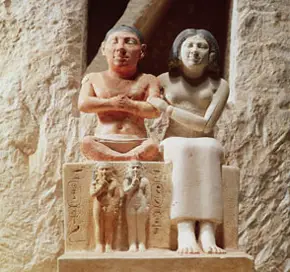Egyptian Families
Ancient Egyptians placed high value on their family life. They considered their children to be a blessing from the gods and so they took exceptional care of them. All people wanted to have children and they would pray to their gods and goddesses so that they could have more children.


Marriage in ancient Egypt was very different than we have today. For peasant girls, they married at around 12 years old and the boys were just a bit older than the girls when they got married. Girls of higher ranking family had the choice to marry when they were older, but these marriages were usually arranged by the parents of the boy and girl. The parents created a pre-nuptial agreement that included the fact that the new wife would get an allowance paid by her new husband. These contracts also said that anything the wife brought to the marriage would always belong to her, even if the marriage ended. Both husband and wife had the right to own land on their own, but usually the wife let the husband take care of the land. Egyptians allowed divorce, and it was done with a statement in front of witnesses. The wife was given the children and the freedom to remarry if she chose.

Egyptian women had a level of equality to the men, but were expected to obey their husbands and fathers. They participated in business arrangements and in the royal families, were often the real power behind the pharaoh’s decisions. Egyptian wives were well respected and often ran the farms and businesses when their husbands were away. Some were hired in the temples and courts as dancers, musicians and singers.

Egyptian boys learned the craft or trade from their fathers and the girls from their mothers. If they had the money, families sent the boys to school at around the age of 7. There isn’t any evidence showing that the girls were educated in a school situation but there are some that did learn to read and write and occasionally even became doctors. When parents passed away, the land would belong to the sons and the household items and jewelry were given to the daughters. If the family did not have any sons, the daughters would inherit everything.

Although in most families, the mother took care of the children, the wealthy families had servants including nannies and maids. Since women of that rank had the ability to be a priestess, there was a need for someone to take care of the children.

Young girls usually wore their hair in what we would call pigtails, while it was common for the boys to have their heads shaved, except for one lock of long hair that was braided. Men and women both wore a variety of wigs to represent the latest styles. The Egyptian style of clothing seemed to remain the same all through the years, with very little that changed. The type of clothing depended upon how much money the family had. The wealthy families wore linens of a fine texture while those that were poor could only afford a coarsely woven linen. In both the Old Kingdom and the Middle Kingdom, men wore kilts. Younger men wore a shorter version, while older men had a longer kilt. When men worked, they wore a loin cloth. Women of higher ranking wore beaded dresses. During the summer months, most children didn’t wear any clothes at all, due to the extreme heat.

Egyptians enjoyed their entertainment and many participated in the various festivals. The festivals were usually to honor their gods and during these times no one worked. They also loved living near the Nile River and there are quite a few images of people fishing and traveling on boats for relaxation. They created many types of indoor board games as well as outdoor boating and hunting games.



